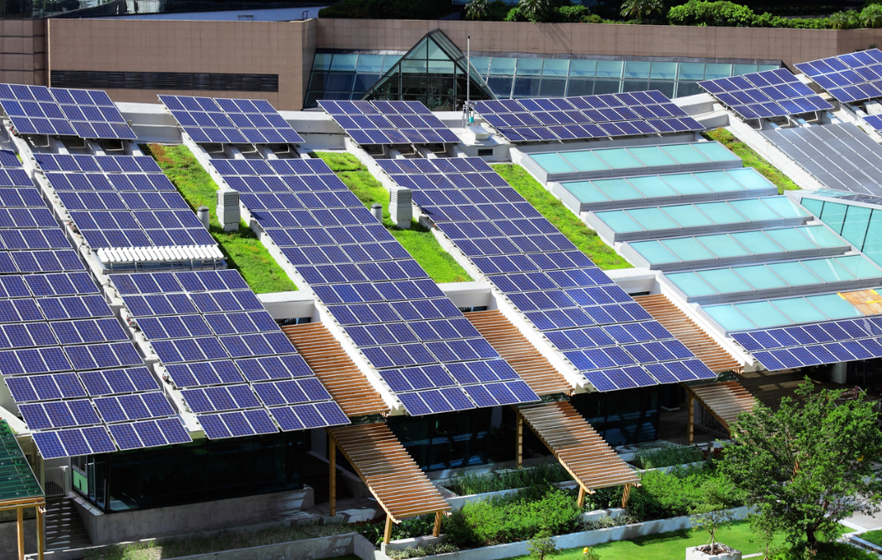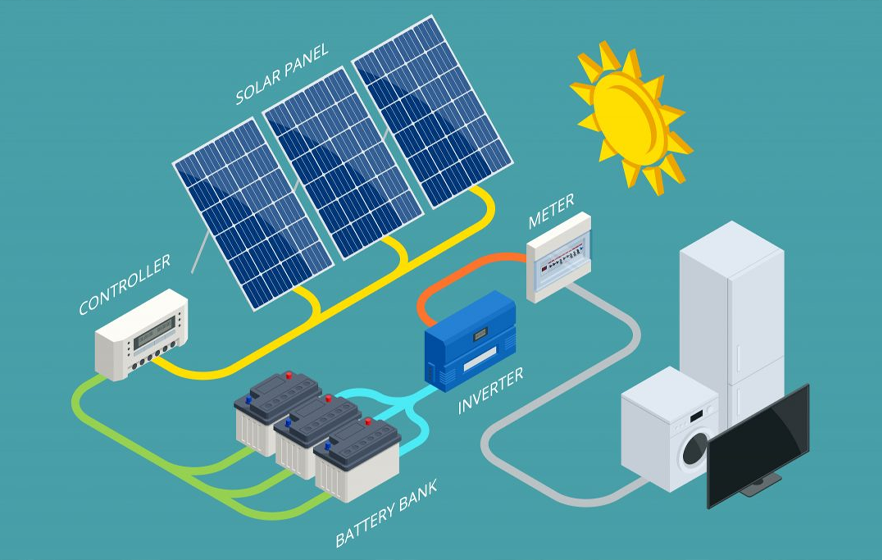
Solar Power describes energy that is useful and obtained directly from the sun. When people consider solar power, they mostly think of photovoltaic (PV) panels which are used to produce electricity. Additionally, other ways to utilize solar energy exist, and some may be even more efficient or practical than solar PV- chiefly solar thermal and passive solar applications.
One of the few energy sources that can be generated on various scales, from utility grade to handheld devices, solar power is easily accessible due to sunlight's wide geographical distribution.
Type of Solar Strategies:
Solar Photovoltaic (PV) is the only direct sunlight-to-electricity technology available. It is also the most portable and can be deployed at almost any scale. Basically, solar PV modules/panels are composed of cells with special semiconductors in them that release electrons when light hits them. The free electrons are then induced to flow, creating an electrical current. To create a solar PV system, multiple cells are wired together to create modules, and then multiple modules are wired together to create an array with a specified capacity for generating electrical power.
Solar Thermal is one of the most efficient and least expensive technologies, but isn't widely deployed. The concept of solar thermal is to convert sunlight directly to heat energy through the use of collector plates. Basic solar thermal techniques are commonly used in solar water heating systems, but more advanced techniques, such as focusing or reflecting sunlight, are increasingly applied to large-scale solar thermal power plants to create steam that drives traditional turbines and generators.
Passive Solar uses good design and thermal materials to reduce energy needs for a building without relying on any active mechanical systems. Through appropriate siting, windows, insulation, thermal mass, and other techniques, passive solar design works with the local climate and geography to collect and distribute heat in cool seasons and block heat in warm seasons.
Distributed Solar refers to the scale of solar application rather than to a specific technology. Most electricity is generated at large central generating facilities located some distance from consumers. Solar and some other forms of renewable energy, however, can also be generated close to communities, individual homes and businesses, or directly to electric cars, streetlights or devices. This "distributed" generation reduces transmission loss and bottlenecks along power lines and also decreases risk of blackouts. An increasing number of states either require or provide incentives for distributed renewable energy generation.
Photovoltaics (PV) are devices that convert sunlight to usable electricity via the photovoltaic effect, a phenomenon that causes certain materials to release electrons when they absorb light. Once the electrons are attracted by an electric field, they flow in an electric current. The basic component of PV panels (or "modules") is the solar cell.
How PV Cells Work
PV consists of solar cells encapsulated in a protective panel, usually with a glass face. The cells themselves are made of a semiconductor material typically in a thin, crystal structure some 0.5 to 350 micrometers thick depending on the technology.
The amount of power generated by a solar cell is a function of how much sunlight is absorbed by the solar panel. The sunlight-to-electricity efficiency of the cell, however, is determined by two key factors:
- The crystal structure of the semiconductor — perfect crystal conducts electrons better than lower grade crystal or non-crystal.
- The semiconductor's "band gap," which refers to the amount of energy required to free an electron from the semiconductor atoms — semiconductors with band gaps that optimally match up with the energy levels of incoming photons have the potential to be more efficient than others.
How Solar Systems Work

A solar panel consists of multiple solar cells wired in a particular fashion. Each cell has a relatively small output, typically less than 0.5 volts, and a certain amount of current, typically 1 to 2 amps. The cells are wired in series until a desired panel voltage is reached, and then multiple strings are wired in parallel until the desired panel output current is reached. This is the power output of the panel in ideal lighting conditions. For example, if each cell output is 0.5 volts at 1.5 amps, then 48 cells may be wired in series, and five strings of 48 series cells are wired in parallel. The result is a panel of 240 cells whose output is 24 volts at 7.5 amps, resulting in a 180-Watt panel.
While a single panel may be used in remote applications to power a light or similar load, for typical power production a group of panels are wired together into an array. As with the wiring for solar cells, the panels are wired in series until a desired voltage is reached, and then multiple strings are wired in parallel until the desired output current, and thus power, is reached.
For example, 20 of the panels in the above example (24 volts at 7.5 amps) may be wired in series as a single string, and then two strings can be wired in parallel. The result is an array of 40 panels whose output is 480 volts at 15 amps, resulting in a 7200-watt system — providing the amount of power consumed by one average Arizona home.
The power from an array is then usually passed through an inverter, if necessary, and fed into a building's power panel, into the power grid, or into a backup system of batteries or other storage.
Power Inverters
Power inverters are devices that convert direct current (DC) power to alternating current (AC) power. All solar panels produce DC power, yet most appliances, and indeed the entire nation's power grid, runs on AC. Thus, the output of a solar array usually goes through an inverter before it can be used. An exception would be a customized system that supplied DC devices such as LED lights or a bank of batteries.
While in years past inverters were a major source of power loss, modern inverters have greater than 90 percent efficiency, meaning that for every 1000 watts of DC power going in, at least 900 watts of AC power comes out. While this is a relatively minor reduction in power, it explains why discrepancies often exist when discussing the system size or production of an installation.
Conclusion
Solar power is generated by converting sunlight into electrical energy. The efficiency of a solar panel is determined by the crystal structure of the semiconductor and the band gap of the semiconductor. Solar panels are wired in series until a desired voltage is reached, and then multiple strings are wired in parallel until the desired output current is reached.
A group of solar panels may be wired together into an array, which will provide power to an inverter that converts direct current (DC) to alternating current (AC). AC power can then be used to power most appliances and devices. Inverters have greater than 90 percent efficiency, meaning for every 1000 watts of DC input, at least 900 watts of AC output comes out.

